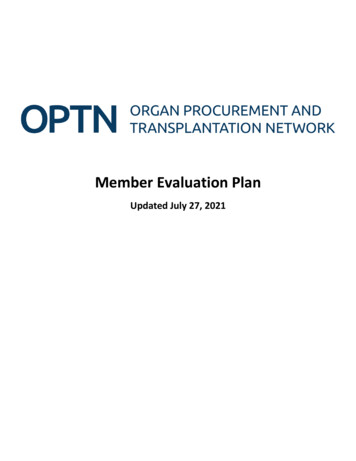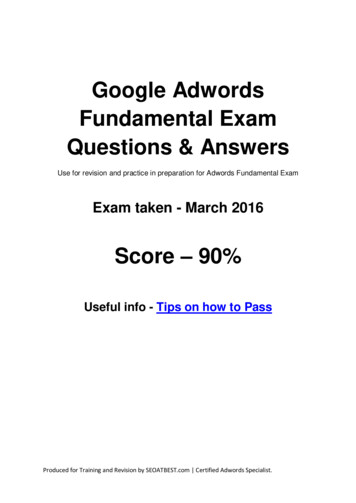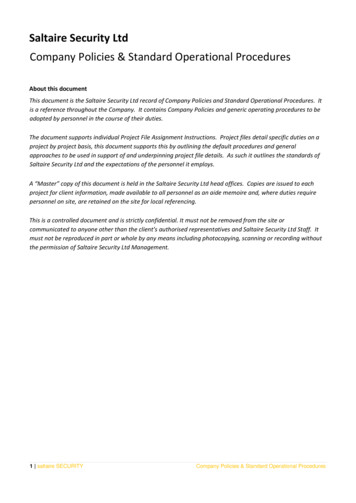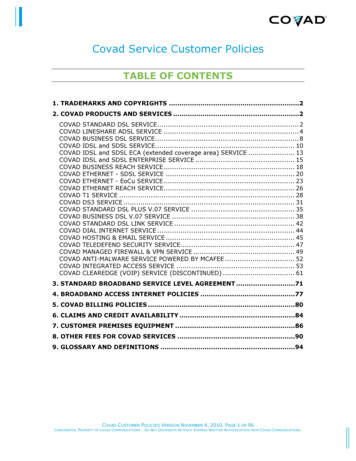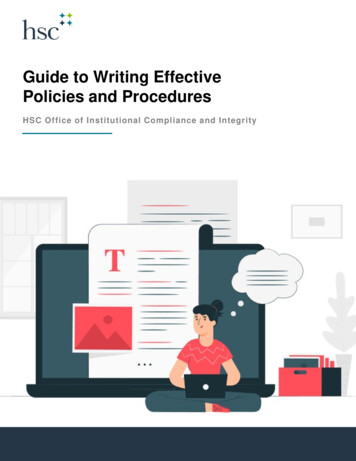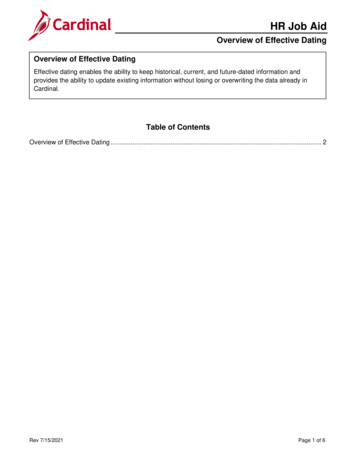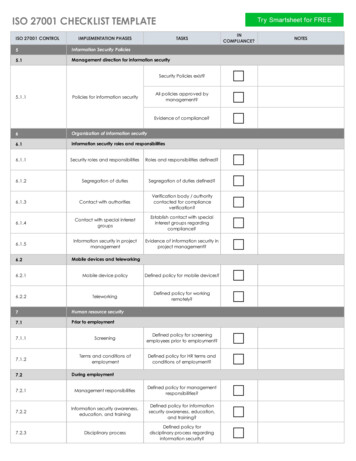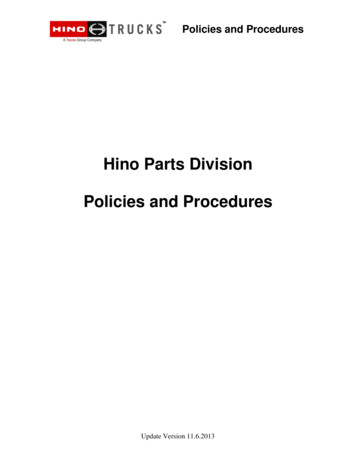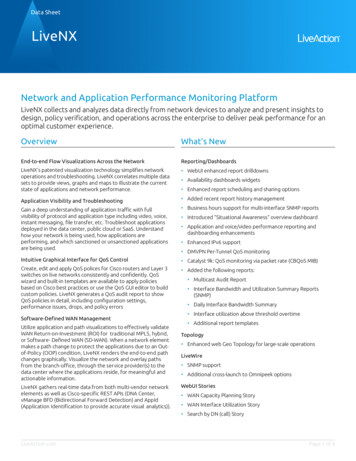![OPTN Policies Effective As Of April 28 2022 [9.9A]](/img/32/optn-policies.jpg)
Transcription
PoliciesContentsPolicy 1:Administrative Rules and Definitions1Policy 2:Deceased Donor Organ Procurement22Policy 3:Candidate Registrations, Modifications, and Removals36Policy 4:Histocompatibility46Policy 5:Organ Offers, Acceptance, and Verification77Policy 6:Allocation of Hearts and Heart-Lungs89Policy 7:Allocation of Intestines125Policy 8:Allocation of Kidneys127Policy 9:Allocation of Livers and Liver-Intestines157Policy 10:Allocation of Lungs212Policy 11:Allocation of Pancreas, Kidney-Pancreas, and Islets243Policy 12:Allocation of Vascularized Composite Allografts (VCA)252Policy 13:Kidney Paired Donation (KPD)253Policy 14:Living Donation270Policy 15:Identification of Transmissible Diseases292Policy 16:Organ and Extra Vessel Packaging, Labeling, Shipping, and Storage301Policy 17:International Organ Transplantation308Policy 18Data Submission Requirements311Policy 19:Data Release321Policy 20:Travel Expense and Reimbursement322
Organ Procurement and Transplantation Network (OPTN) PoliciesPolicy 1: Administrative Rules and Definitions1.1Rules of ation of Organs during Emergencies201.5Department of Defense Directive211.1 Rules of ConstructionThe rules and definitions set forth in this Policy apply to all OPTN Policies.1.1.ATimeA day ends at midnight Eastern Standard Time (EST).1.1.BHeadings, Notes, and HistoryAll headings, notes, and history sections of these Policies, are intended only as guidance and tosupplement the OPTN Policies and are not part of the Policies. These sections and headings arenonbinding to members and should not be treated as policy or used to infer the intent of thePolicies.1.1.CReporting of Information to the OPTNMembers must report requested information to the OPTN to fulfill membership requirementsand to ensure compliance with OPTN Policies and Bylaws. The OPTN will determine the requiredmethod and format for reporting any information required by OPTN Policies and Bylaws,including the requirement to submit specific forms at defined times.1.1.DSignatureSignatures necessary to meet OPTN Obligations may be handwritten or electronically produced,including digital or electronically imaged signatures.1.2 DefinitionsThe definitions that follow are used to define terms specific to the OPTN Policies.AActive candidateA candidate on the waiting list who is currently suitable for transplantation and eligible to receive organoffers.AgentA person legally authorized to act on behalf of another person.Effective Date: 4/28/2022Page 1
OPTN PoliciesPolicy 1: Administrative Rules and DefinitionsAllocation MELD or PELD ScoreThe highest exception or calculated MELD or PELD score available to the candidate according to Policy.Allocation MELD or PELD score includes liver-intestine points.Alternative allocation systemA type of variance that allows members who are permitted to join the variance to allocate organsdifferently than the OPTN Policies.Alternative local unit (ALU)A type of variance that creates a distinct geographic area for organ procurement and distribution.Alternative point assignment systemA type of variance that allows members who are permitted to join the variance to assign points fororgan allocation differently than required by the OPTN Policies.Antigen mismatchAn antigen mismatch occurs when an identified deceased or living donor antigen is not recognized asequivalent to the recipient’s own antigens. In cases where a donor or candidate only has one antigenidentified at a human leukocyte antigen (HLA) locus (A, B, or DR), the antigens are considered to beidentical at that locus.AuthorizationThe act of granting permission for a specific act. This is sometimes called consent, which is not to beconfused with informed consent.BBackup offerAn organ offer made to a lower ranked candidate on a deceased donor match run after a transplanthospital accepts an organ on behalf of a higher ranked candidate, but before the organ is transplanted.Bridge donorA Kidney Paired Donation (KPD) donor who does not have a match identified during the same match runas the donor’s paired candidate and continues a chain in a future match run.Business daysCalendar days excluding Saturdays, Sundays, and federal holidays.CCalculated MELD or PELD ScoreThe highest non-exception MELD or PELD score available to the candidate according to Policy.Calculated MELD or PELD score excludes liver-intestine points.Effective Date: 4/28/2022Page 2
OPTN PoliciesPolicy 1: Administrative Rules and DefinitionsCalculated Panel Reactive Antibody (CPRA)The percentage of deceased donors expected to have one or more of the unacceptable antigensindicated on the waiting list for the candidate. The CPRA is derived from HLA antigen/allele group andhaplotype frequencies for the different ethnic groups in proportion to their representation in thenational deceased donor population.CandidateA person registered on the organ transplant waiting list. When a candidate appears on the match run,the candidate is then referred to as a potential transplant recipient (PTR).ChainA set of KPD matches that begins with a donation from a non-directed living donor to that KPD donor’smatched candidate. This candidate’s paired living donor then donates to the KPD donor’s matchedcandidate. A chain continues until a living donor donates to an orphan candidate, a waiting listcandidate or is a bridge donor.ClassificationA collection of potential transplant recipients grouped by similar characteristics and within a givengeographical area. Classifications are used to rank potential recipients of deceased or living donororgans. A collection of ranked classifications of potential transplant recipients is also known as an organallocation algorithm.Closed varianceA variance that is not open for other members to join it.Covered Vascularized Composite Allograft body parts (covered VCAs)The body parts listed below are covered VCAs. Covered VCAs are categorized by type as follows:Effective Date: 4/28/2022Page 3
OPTN PoliciesPolicy 1: Administrative Rules and DefinitionsCovered VCA(s)Type:Any group of vascularized body parts from theupper limbUpper limbFace, larynx, vascularized parathyroid gland,scalp, trachea, vascularized thyroid, and any othervascularized body parts from the head and neckHead and neckAbdominal wall, symphysis pubis, and any groupof vascularized skeletal elements of the pelvisAbdominal wallUterus, internal and external male and femalegenitalia, and urinary bladderGenitourinary organAdrenal and thymusVascularized glandPelvic structures that are attached to the lowerlimb and transplanted intact, gluteal region,vascularized bone transfers from the lowerextremity, toe transfers, and any group ofvascularized body parts from the lower limbLower limbSpine axis, chest wall, and other composite graftof vascularized muscle, bone, nerve, or skinMusculoskeletal composite graft segmentSpleenSpleenDDayCalendar day.Deceased donorAn individual from whom at least one organ is recovered for the purpose of transplantation afterdeclaration of death.Directed donationThe allocation of a deceased or living donor organ to a specific candidate named by the person whoauthorized the donation.Domino donorAn individual who has an organ removed as a component of medical treatment and who receives areplacement organ. The organ that was removed is transplanted into another person.Donation after Circulatory Death (DCD)Donation after Circulatory Death (DCD) describes the organ recovery process that may occur followingdeath by irreversible cessation of circulatory and respiratory functions. A DCD donor may also be calleda non-heartbeating, asystolic, or donation after cardiac death donor.Effective Date: 4/28/2022Page 4
OPTN PoliciesPolicy 1: Administrative Rules and DefinitionsDonation Service Area (DSA)The geographic area designated by the Centers for Medicare and Medicaid Services (CMS) that is servedby one organ procurement organization (OPO), one or more transplant hospitals, and one or moredonor hospitals.Donor hospitalThe hospital where the deceased or living donor is admitted.Donor IDA unique identification assigned to each deceased and living donor by the OPTN.Donor recordThe record maintained by the OPO regarding an individual deceased donor.EEligible deathFor reporting purposes of DSA performance assessments, an eligible death for deceased organ donationis defined as the death of a patient who meets all the following characteristics: Is 75 years old or lessIs legally declared dead by neurologic criteria according to state or local lawHas body weight of 5 kg or greaterHas a body mass index (BMI) of 50 kg/m2 or lessHas at least one kidney, liver, heart or lung that is deemed to meet the eligible data definition asdefined below:o The kidney would initially meet the eligible data definition unless the donor meets any of thefollowing criteria: Greater than 70 years old Age 50-69 years with history of type 1 diabetes for more than 20 years Polycystic kidney disease Glomerulosclerosis greater than or equal to 20% by kidney biopsy Terminal serum creatinine greater than 4.0 mg/dL Chronic renal failure No urine output for 24 hours or longero The liver would initially meet the eligible data definition unless the donor meets any of thefollowing criteria: Cirrhosis Terminal total bilirubin greater than or equal to 4 mg/dL Portal hypertension Macrosteatosis greater than or equal to 50% or fibrosis greater than or equal to stage II Fulminant hepatic failure Terminal AST/ALT greater than 700 U/Lo The heart would initially meet the eligible data definition unless the donor meets any of thefollowing criteria: Greater than 60 years oldEffective Date: 4/28/2022Page 5
OPTN PoliciesPolicy 1: Administrative Rules and Definitions45 years old or older with a history of 10 or more years of HTN or 10 or more years of type 1diabetes History of coronary artery bypass graft (CABG) History of coronary stent/intervention Current or past medical history of myocardial infarction (MI) Severe vessel diagnosis as supported by cardiac catheterization (that is more than 50percent occlusion or 2 vessel disease) Acute myocarditis or endocarditis, or both Heart failure due to cardiomyopathy Internal defibrillator or pacemaker Moderate to severe single valve or 2-valve disease documented by echo or cardiaccatheterization, or previous valve repair Serial echo results showing severe global hypokinesis Myxoma Congenital defects (surgically corrected or not)The lung would initially meet the eligible data definition unless the donor meets any of thefollowing criteria: Greater than 65 years old Diagnosed with COPD Terminal PaO2/FiO2 less than 250 mmHg Asthma (with daily prescription) Asthma is the cause of death Pulmonary fibrosis Previous lobectomy Multiple blebs documented on computed axial tomography (CAT) scan Pneumonia as indicated on computed tomography (CT), X-ray, bronchoscopy, or cultures Bilateral severe pulmonary contusions as per CT oIf a deceased patient meets the above criteria they would be classified as an eligible death unless thedonor meets any of the following criteria: The donor goes to the operating room with intent to recover organs for transplant and all organs aredeemed not medically suitable for transplantThe donor exhibits any of the following active infections (with a specific diagnosis):o Bacterial: tuberculosis, gangrenous bowel or perforated bowel or intra-abdominal sepsiso Viral: HIV infection by serologic or molecular detection, rabies, reactive hepatitis B surfaceantigen, retroviral infections including viral encephalitis or meningitis, active herpes simplex,varicella zoster, or cytomegalovirus viremia or pneumonia, acute epstein barr virus(mononucleosis), West Nile virus infection, or SARS. However, an HIV positive organ procuredfor transplantation into an HIV positive recipient at a transplant hospital that meets therequirements in Policy 15.7: Open Variance for the Recovery and Transplantation of Organs fromHIV Positive Donors would still meet the requirements of an eligible death, according to theOPTN Final Rule.o Fungal: active infection with cryptococcus, aspergillus, histoplasma, coccidioides, activecandidemia or invasive yeast infectiono Parasites: active infection with trypanosoma cruzi (Chagas'), Leishmania, strongyloides, ormalaria (plasmodium sp.)Effective Date: 4/28/2022Page 6
OPTN PoliciesoPolicy 1: Administrative Rules and DefinitionsPrion: Creutzfeldt-Jacob diseaseThe following are general exclusions: Aplastic anemia, agranulocytosisCurrent malignant neoplasms, except non-melanoma skin cancers such as basal cell and squamouscell cancer and primary CNS tumors without evident metastatic diseasePrevious malignant neoplasms with current evident metastatic diseaseA history of melanomaHematologic malignancies: leukemia, Hodgkin's disease, lymphoma, multiple myelomaActive fungal, parasitic, viral, or bacterial meningitis or encephalitisNo discernible cause of deathEmergencyAny situation that compromises telecommunications, transportation, function of or access to the OPTNcomputer match system.ExchangeA set of KPD matches that form a chain, a two-way exchange, or a three-way exchange.Extra vesselsVessels taken during recovery of deceased or living donor organs with the intent to be used in organtransplantation only. Extra vessels are not connected to the organ. Extra vessels are subject to the samemember requirements applying to the organ unless otherwise specified.FFinal Rule42 CFR 121 et seq.GGeographical AreaA physical area used to group potential transplant recipients in a classification.Graft failureFor all organs except pancreas, graft failure occurs when any of the following occurs: A recipient’s transplanted organ is removedA recipient diesA recipient is placed on a chronic allograft support systemPancreas graft failure occurs when any of the following occurs: A recipient’s transplanted pancreas is removedA recipient re-registers for a pancreasA recipient registers for an islet transplant after receiving a pancreas transplantA recipient’s total insulin use is greater than or equal to 0.5 units/kg/day for a consecutive 90 daysEffective Date: 4/28/2022Page 7
OPTN Policies Policy 1: Administrative Rules and DefinitionsA recipient diesHHepatitis B Virus (HBV)Hepatitis B is a vaccine-preventable liver infection caused by the hepatitis B virus (HBV).Hepatitis C Virus (HCV)Hepatitis C is a liver infection caused by the hepatitis C virus (HCV).Histocompatibility LaboratoryA histocompatibility laboratory is a member of the OPTN. A histocompatibility laboratory member is anyhistocompatibility laboratory that performs histocompatibility testing, including but not limited to,Human Leukocyte Antigen (HLA) typing, antibody screening, compatibility testing, or crossmatching, andserves at least one transplant hospital member or OPO. Histocompatibility laboratory members areeither independent or hospital-based. See also Independent Histocompatibility Laboratory and Hospitalbased Histocompatibility Laboratory definitions in the OPTN Bylaws.Host Organ Procurement Organization (Host OPO)The OPO responding to a deceased organ donor referral from a hospital.Human Immunodeficiency Virus (HIV)Human Immunodeficiency Virus (HIV) is a virus that attacks the body’s immune system. If HIV is nottreated, it can lead to Acquired Immunodeficiency Syndrome (AIDS).IImminent neurological deathImminent Neurological Death is defined as the death of a patient who meets both of the followingcriteria: Meets the eligible death definition with the exception that the patient has not been declared legallydead by neurologic criteria according to current standards of accepted medical practice and state orlocal law.Has a severe neurological injury requiring ventilator support who, upon clinical evaluationdocumented in the OPO record or donor hospital chart, has no observed spontaneous breathing andis lacking at least two of the additional brain stem reflexes that follow:oooooooPupillary reactionResponse to iced caloricGag ReflexCough ReflexCorneal ReflexDoll's eyes reflexResponse to painful stimuliA patient who is unable to be assessed neurologically due to administration of sedation orhypothermia protocol does not meet the definition of an imminent neurological death.Effective Date: 4/28/2022Page 8
OPTN PoliciesPolicy 1: Administrative Rules and DefinitionsInactive candidateA candidate that is temporarily unavailable or unsuitable for transplantation, and appears as inactive onthe waiting list.Independent living donor advocate (ILDA)A person available to assist potential living donors in the living donation process.Intended incompatibleDonor and candidate primary blood types that are biologically incompatible, but transplantation ispermissible according to OPTN policy.IntestineStomach, small intestine, large intestine, or any portion of the gastro-intestinal tract as determined bythe medical needs of individual candidates.Islet infusionAn infusion of islets from a single deceased donor. If a recipient receives islets from multiple donorssimultaneously, then each donor’s islets must be counted as a separate infusion.KKidney Paired Donation (KPD)The donation and receipt of human kidneys under the following circumstances: An individual (the first living donor) desires to make a living donation of a kidney specifically to aparticular patient (the first patient), but the first living donor is biologically incompatible as a donorfor the first patient.A second individual (the second living donor) desires to make a living donation of a kidneyspecifically to a second particular patient (the second patient), but the second living donor isbiologically incompatible as a donor for the second patient.The first living donor is biologically compatible as a donor of a kidney for the second patient, and thesecond living donor is biologically compatible as a donor of a kidney for the first patient. If there isany additional donor-patient pair as described above, each living donor in the group of donorpatient pairs is biologically compatible as a living donor of a kidney for a patient in the group.All donors and patients in the group of donor-patient pairs enter into a single agreement to donateand receive the kidneys, respectively, according to biological compatibility within the group.Other than described as above, no valuable consideration is knowingly acquired, received, or otherwisetransferred for the donation of the kidneys.Effective Date: 4/28/2022Page 9
OPTN PoliciesPolicy 1: Administrative Rules and DefinitionsLLiving donorA living individual from whom at least one organ is recovered for transplantation.Living donor recipientA transplant recipient that receives a living donor organ.Living donor organAn organ from a living donor.Lower respiratory specimenA sample taken from the respiratory system within the trachea or below. Sputum, tracheal aspirate,bronchial suction, bronchial wash, bronchoalveolar lavage (BAL), and lung biopsy are considered lowerrespiratory specimens.Lung allocation score (LAS)The scoring system used to measure illness severity in the allocation of lungs to candidates 12 years andolder.MMatch MELD or PELD ScoreThe MELD or PELD score available to the candidate at the time of the match for a deceased donor liveror liver-intestine.MatchA donor and the donor’s matched candidate. This includes deceased, living, and KPD donors.Match runA process that filters and ranks waiting list candidates based on deceased or non-directed living donorand candidate medical compatibility and organ-specific allocation criteria. A match run is also used togenerate a set of potential exchanges for a KPD donor and candidate.Match systemThe computerized algorithm used to prioritize patients waiting for organs.Matched candidateThe candidate that a KPD match run identifies as a potential transplant recipient of a living donor’skidney.Matched donorA living donor identified by a KPD match run as a potential donor for a candidate.Matched recipientA matched KPD candidate that has received a transplant.Effective Date: 4/28/2022Page 10
OPTN PoliciesPolicy 1: Administrative Rules and DefinitionsMedical recordA chronological account of a patient's examination and treatment that includes the patient's medicalhistory and complaints, the physician's physical findings, the results of diagnostic tests and procedures,and medications and therapeutic procedures.Model for End Stage Liver Disease (MELD)The scoring system used to measure illness severity in the allocation of livers to adults.MemberThe OPTN membership categories are transplant hospital members, OPO members, histocompatibilitylaboratory members, medical/scientific members, public organization members, business members, andindividual members.MonthCalendar month.Multi-organ candidateA candidate registered on the waiting lists for more than one organ type.NNational Organ Transplantation Act (NOTA)42 U.S.C. § 273 et seq.Non-Directed Donor (NDD)A KPD donor that enters KPD without a paired candidate or a living donor who donates an organ anddoes not specify an intended recipient.Non-domino therapeutic donorAn individual who has an organ removed as a component of medical treatment and whose organ istransplanted into another person. The donor does not receive a replacement organ.Non-US citizen/Non-US residentA non-citizen of the United States for whom the United States is not the primary place of residence.Non-US citizen/US residentA non-citizen of the United States for whom the United States is the primary place of residence.OOpen varianceA variance that allows members other than the members that applied for the variance to join it.Effective Date: 4/28/2022Page 11
OPTN PoliciesPolicy 1: Administrative Rules and DefinitionsOPTN computer match programA set of computer-based instructions that compares data on a deceased organ donor with data ontransplant candidates on the waiting list and ranks the candidates according to OPTN Policies todetermine the priority for allocating the deceased donor organs.OPTN ContractorThe corporation currently operating the Organ Procurement and Transplantation Network (OPTN) undercontract with HHS. In 1984 NOTA directed the Secretary of HHS to establish by contract the OPTN whichshall be a private, non-profit entity that has an expertise in organ procurement and transplantation. TheUnited Network for Organ Sharing (UNOS) is the current OPTN Contractor.OPTN obligationsMembers agree to comply with all OPTN obligations. OPTN obligations include all the applicableprovisions of NOTA, OPTN Final Rule, OPTN Charter, OPTN Bylaws, and OPTN Policies.OPTN organ tracking systemA software application developed and distributed by the OPTN Contractor that uses barcode technologyto generate printed labels for organ packaging and tracking.OrganA human kidney, liver, heart, lung, pancreas, intestine (including the esophagus, stomach, small or largeintestine, or any portion of the gastrointestinal tract), or vascularized composite allograft. Blood vessels,including extra vessels, recovered from an organ donor during the recovery of such organ(s) areconsidered part of an organ with which they are procured for purposes of these Policies if the vesselsare intended for use in organ transplantation and labeled ‘‘For use in organ transplantation only.’’Organ allocation policiesOPTN Policies: Policy 6: Allocation of Hearts and Heart-Lungs, Policy 7: Allocation of Intestines, Policy 8:Allocation of Kidneys, Policy 9: Allocation of Livers and Liver-Intestines, Policy 10: Allocation of Lungs, andPolicy 11: Allocation of Pancreas, Kidney-Pancreas, and Islets, and Policy 12: Allocation of CoveredVascularized Composite Allografts.Organ CenterThe Organ Center is responsible for facilitating organ sharing among transplant centers, organprocurement organizations and histocompatibility laboratories across the U.S. The primary functions ofthe Organ Center are to: assist in placing donated organs for transplantation, assist organ procurementorganizations with running the donor/recipient computer matching process, assist with transportationof organs and associated tissues for the purposes of transplantation, act as a resource to the transplantcommunity regarding organ sharing policies. The Organ Center operates 24 hours a day, 365 days a year.Organ offer acceptanceWhen the transplant hospital notifies the host OPO that it accepts the organ offer for an intendedrecipient, pending review of organ anatomy. For kidney, acceptance is also pending final crossmatch.Organ offer refusalWhen the transplant hospital notifies the OPTN or the host OPO that they are declining the organ offer.Effective Date: 4/28/2022Page 12
OPTN PoliciesPolicy 1: Administrative Rules and DefinitionsOrgan procurement organization (OPO)An organization authorized by the Centers for Medicare and Medicaid Services, under Section 1138(b) ofthe Social Security Act, to procure organs for transplantation.Organ Procurement and Transplantation Network (OPTN)The network established according to Section 372 of the Social Security Act.Organ transplantOrgan transplants include solid organ transplants and islet infusions. An organ transplant begins at thestart of organ anastomosis or the start of an islet infusion.An organ transplant procedure is complete when any of the following occurs: The chest or abdominal cavity is closed and the final skin stitch or staple is applied.The transplant recipient leaves the operating room, even if the chest or abdominal cavity cannot beclosed.The islet infusion is complete.Orphan candidateA KPD candidate who does not receive a kidney transplant from the matched donor for any reason afterthe candidate’s paired donor has donated.Other antibody specificitiesAntigens specified for a KPD candidate that may result in a positive or negative crossmatch. The rate ofpositive crossmatches would be expected to be higher against KPD donors who express these antigens.PPairA KPD donor and the KPD donor’s paired KPD candidate.Paired candidateThe KPD candidate to whom a KPD donor intended to donate his organ before entering into KPD.Paired donorA living donor who intended to donate his organ to his paired candidate before entering into KPD.Paired donor’s transplant hospitalThe transplant hospital that enters the donor in a KPD program.Paired recipientA paired KPD candidate that has received a transplant.PatientIncludes all of the following:Effective Date: 4/28/2022Page 13
OPTN Policies1.2.3.4.5.Policy 1: Administrative Rules and DefinitionsPotential deceased donors undergoing an OPO’s potential donor evaluation, donor managementand procurement processesPotential candidates and potential living donors undergoing a transplant program’s evaluationprocessCandidatesLiving donors being followed by a transplant programRecipients being followed by a transplant programPediatric End Stage Liver Disease (PELD)The scoring system used to measure illness severity in the allocation of livers to pediatric candidates.PHS Guideline, see United States Public Health Service (PHS) Guideline.Potential transplant recipient (PTR)A candidate who appears on a match run.Primary potential transplant recipientThe first candidate according to match run sequence for whom an organ has been accepted.Primary waiting timeThe longest time period a candidate registered on the waiting list has been waiting for a specific organtransplant procedure, after having met qualifying criteria to accrue waiting time for that organ. Primarywaiting time is based on the candidate’s qualifying date, registration date, and waiting time accrued.Provisional yesWhen the transplant hospital notifies the OPTN or the host OPO that they have evaluated the offer andare interested in accepting the organ or receiving more information about the organ.QQualified health care professionalA person who is qualified to perform blood type reporting or verification requirements as defined in theOPO, transplant hospital, or recovery hospital written protocol.Qualified specimenA blood specimen without evidence of hemodilution.Qualifying dateThe date that a candidate began accruing waiting time.Effective Date: 4/28/2022Page 14
OPTN PoliciesPolicy 1: Administrative Rules and DefinitionsRReceiving transplant programThe transplant program that receives a deceased or living donor organ from an OPO, transplant hospital,or recovery hospital.RecipientA candidate that has received an organ transplant.Recovery hospitalA healthcare facility that recovers living donor organs.RegionFor administrative purposes, OPTN membership is divided into 11 geographic regions. Members belongto the Region in which they are located. The Regions are as follows:Region 1:Region 2:Connecticut, Maine, Massachusetts, New Hampshire, Rhode Island, and Eastern VermontDelaware, District of Columbia, Maryland, New Jersey, Pennsylvania, West Virginia, and thepart of Northern Virginia in the Donation Service Area served by the Washington RegionalTransplant Community (DCTC) OPO.Region 3: Alabama, Arkansas, Florida, Georgia, Louisiana, Mississippi, and Puerto RicoRegion 4: Oklahoma and TexasRegion 5: Arizona, California, Nevada, New Mexico, and UtahRegion 6: Alaska, Hawaii, Idaho, Montana, Oregon, and WashingtonRegion 7: Illinois, Minnesota, North Dakota, South Dakota, and WisconsinRegion 8: Colorado, Iowa, Kansas, Missouri, Nebraska, and WyomingRegion 9: New York and Western VermontRegion 10: Indiana, Michigan, and OhioRegion 11: Kentucky, North Carolina, South Carolina, Tennessee, and VirginiaRegistration dateThe date that the candidate registers on the waiting list.SSharing arrangementsA type of variance that permits two or more OPOs to share organs.Source documentAn original record of results, or a photocopy or digital copy of the original record.TTherapeutic donorAn individual who has an organ remo
A set of KPD matches that begins with a donation from a non-directed living donor to that KPD donor's matched candidate. This candidate's paired living donor then donates to the KPD donor's matched candidate. A chain continues until a living donor donates to an orphan candidate, a waiting list candidate or is a bridge donor.
